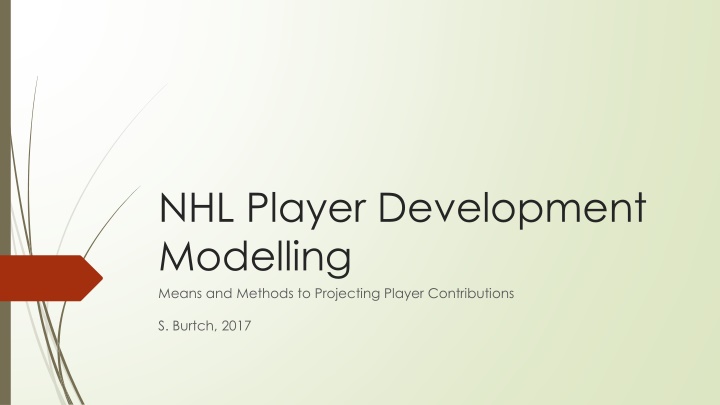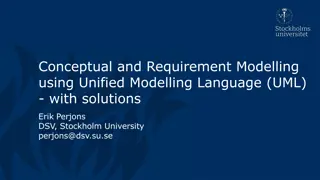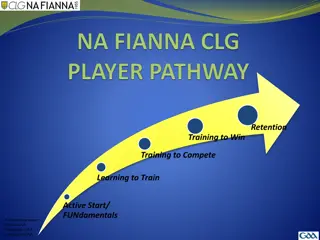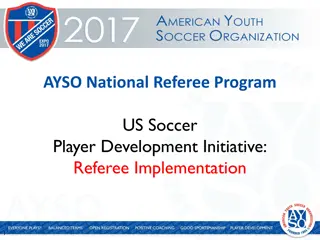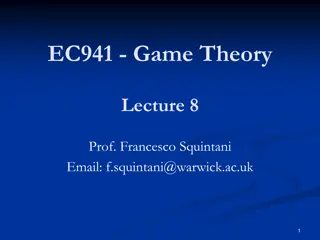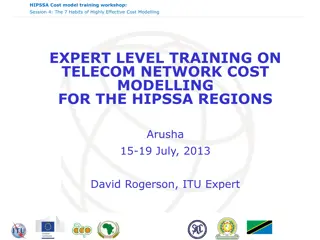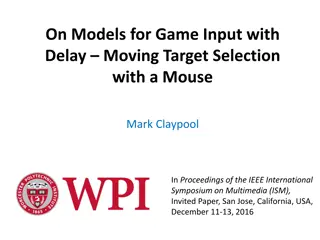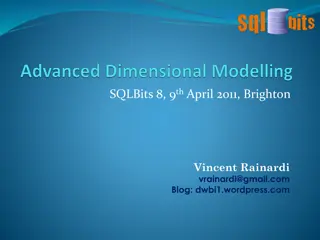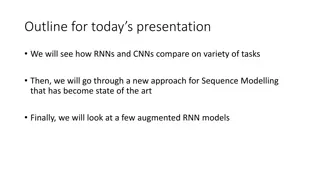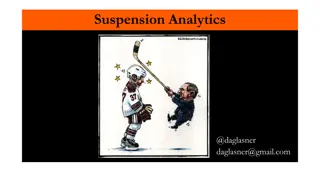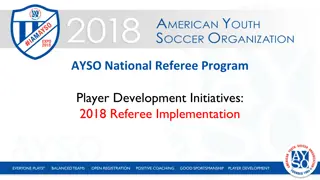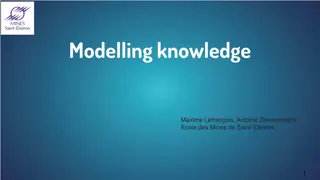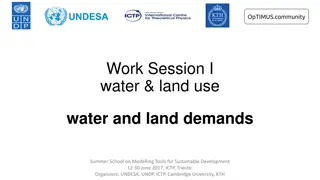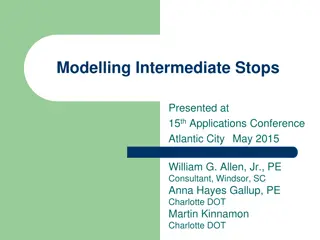Advanced Methods in NHL Player Development Modelling
Explore various means and methods for projecting NHL player contributions through player career trajectory descriptions, statistical exercises like Marcel Projections, and identifying similar players using player similarity scores and K-Nearest Neighbours algorithms. Learn how to enhance player projections for better performance insights.
Download Presentation

Please find below an Image/Link to download the presentation.
The content on the website is provided AS IS for your information and personal use only. It may not be sold, licensed, or shared on other websites without obtaining consent from the author.If you encounter any issues during the download, it is possible that the publisher has removed the file from their server.
You are allowed to download the files provided on this website for personal or commercial use, subject to the condition that they are used lawfully. All files are the property of their respective owners.
The content on the website is provided AS IS for your information and personal use only. It may not be sold, licensed, or shared on other websites without obtaining consent from the author.
E N D
Presentation Transcript
NHL Player Development Modelling Means and Methods to Projecting Player Contributions S. Burtch, 2017
Player Career Trajectory Description Useful for Generalization Player Production vs Age Cumulative Points (Krzywicki, 2008)
Player Career Trajectory Description Useful for Generalization Points Per GP / Per 60 (Desjardins, 2010; Tuslky, 2013, 2014) Shot Rates (Tulsky 2014)
Player Career Trajectory Description Useful for Generalization Save Percentage (Burtch, 2013; Tulsky 2013)
Projection as a Statistical Exercise Marcel Projections The Marcel the Monkey Forecasting System (or the Marcels for short) is the most advanced forecasting system ever concieved. Not. Actually it is the most basic forecasting system you can have, that uses as little intelligence as possible. (Tom Tango, 2012 Marcels first introduced in 2004) Projecting Goaltender Performance Marcels (Garik16, 2014; Tulsky, 2014) Projecting Skater Performance Marcels (Galimini, 2015)
More Detailed Projections in Other Sports PECOTA / Steamer / ZiPs (baseball) CARMELO (basketball) APROPOS (soccer) All employ a similar logic Try to project player development by exploring trajectory of similar players This raises 3 key questions
1. How Do We Identify Similar Players? Player Similarity Scores (Hockey/Basketball/Baseball/Football-Reference.com, 2008) Uses overall career score and shape similarity Does not account for variation by age Euclidean Distance Most recently applied in Hockey Statistics by Corsica.Hockey Statistically Similar Players (Perry, 2016) Identifying Playing Styles With Clustering (Stimson, 2017) Examining Which Players are Most Similar To Current Red Wings (Iyer, 2017)
1. How Do We Identify Similar Players? Using K-Nearest Neighbours Algorithms to identify similar player types/styles We seek to identify similarity by age/season across a variety of GAR metrics KNN Matrix Data using GAR data (courtesy Dawson Sprigings, 2008-2017) Weight each GAR metric according to year-over-year auto-correlation Scale each GAR metric to account for players with limited GP and thus maximize the size of the sample This was accomplished by modeling the underlying relationships between GP and individual GAR components to account for individual skaters with low GP
1. How Do We Identify Similar Players? Using K-Nearest Neighbours Algorithms to identify similar player types/styles We seek to identify similarity by age/season across a variety of GAR metrics We thus obtain our KNN Age Matrix 1479 Individual Skaters 6 GAR metrics per year of age Spanning ages 18 to 44 (Jaromir Jagr will boost the upper bound to 45 this year) 1479 x 6 x 27 = 239,598 data points of fun for comparison
1. How Do We Identify Similar Players? For each individual skater we compare them to all other skaters filtered by position (F or D) using their GAR data from age 18 to the age of the skater last season (2016-17) This is done using a KNN Algorithm in R identifying the 5 most similar skaters Issues with this method as applied Some skaters have peers of the same current age within their 5 most similar players e.g. William Nylander s 2 most similar skaters were Christian Dvorak of the Arizona Coyotes and Brayden Point of the Tampa Bay Lightning. All 3 skaters are in the midst of their age 21 season.
2. How Do We Project Into The Future? Two obvious options exist 1 Forecast using the average outcomes of most similar skaters in the following season 2 Forecast using the average proportional change for the most similar skaters in the following season The third possibility is a blending of the two aforementioned methods
Projection of GAR by Age Leon Draisaitl GAR Projection 18.00 15.35 PROP 16.00 14.00 11.67 12.00 11.87 AVG 10.03 10.00 8.96 GAR 8.00 6.00 4.00 2.00 0.00 0.00 18 19 20 21 22 BRENDAN.GALLAGHER TYLER.SEGUIN EVANDER.KANE MATT.DUCHENE FILIP.FORSBERG LEON.DRAISAITL.AVG LEON.DRAISAITL.PROP
Projection of GAR by Age Oscar Klefbom GAR Projection 13.02 Prop 14.00 12.37 11.74 12.00 11.23 10.00 9.65 Avg 8.00 6.00 4.00 2.00 0.00 0.00 0.00 0.00 18 19 20 21 22 23 24 RYAN.PARENT ALEX.PIETRANGELO ROMAN.JOSI JOHN.CARLSON KRIS.LETANG OSCAR.KLEFBOM.AVG OSCAR.KLEFBOM.PROP
What Do We Call It? Goals Above Replacement Projection Employing Newly GARPENLOV Leveraged Observations & Variance
